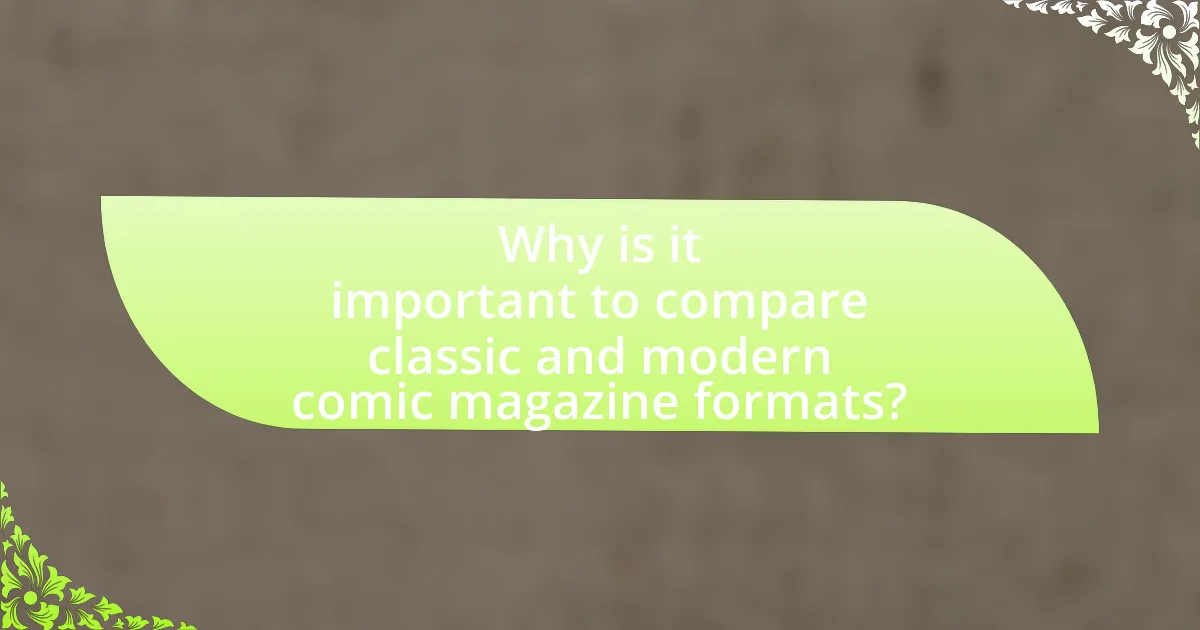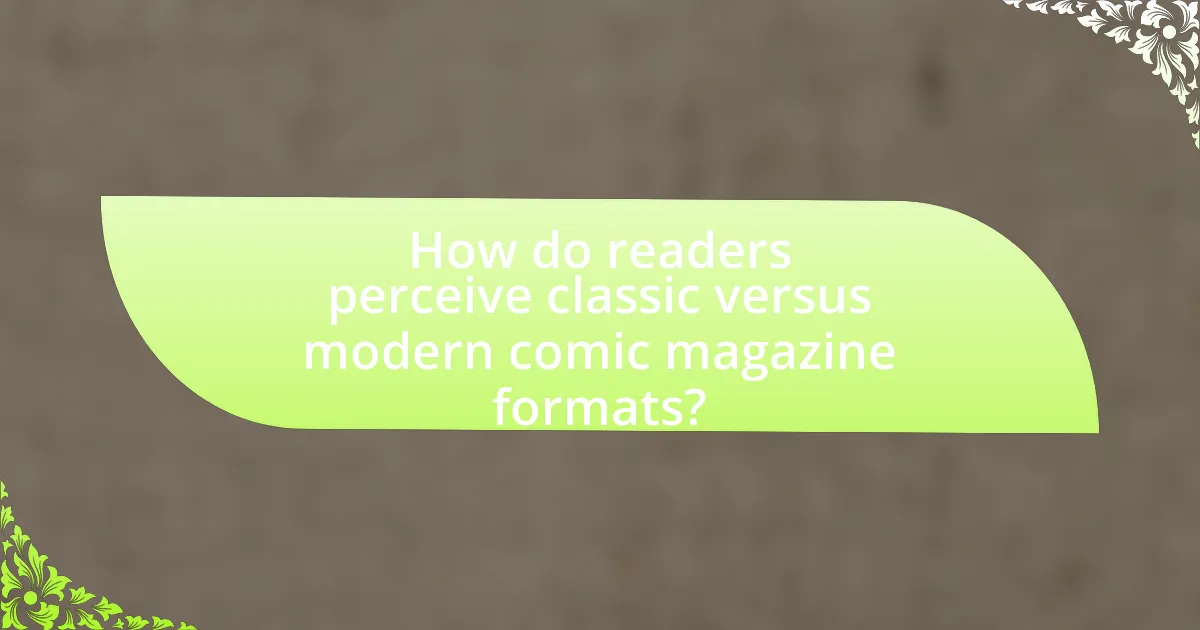The article provides a comparative review of classic and modern comic magazine formats, highlighting key differences in size, paper quality, storytelling techniques, and artistic styles. It traces the evolution of comic magazines from their early 20th-century origins to contemporary digital formats, emphasizing how cultural influences and technological advancements have shaped these changes. The discussion includes defining characteristics of classic comics, innovations in modern formats, and the impact of audience preferences on the comic industry. Additionally, it addresses the challenges faced by both formats in today’s digital landscape and explores strategies for enhancing reader engagement.

What are the key differences between classic and modern comic magazine formats?
Classic comic magazine formats typically feature a smaller page size, often around 6.5 by 10 inches, and are printed on lower-quality paper, while modern comic magazines generally utilize larger dimensions, such as 7 by 10.5 inches or larger, and are printed on higher-quality, glossy paper. The classic format often includes serialized storytelling with fewer issues per storyline, whereas modern formats frequently embrace graphic novels and trade paperbacks that allow for complete narratives in a single volume. Additionally, classic comics often relied on a limited color palette and simpler art styles, while modern comics utilize advanced printing techniques that support vibrant colors and intricate artwork, reflecting advancements in technology and artistic trends.
How did the classic comic magazine format evolve over time?
The classic comic magazine format evolved significantly from its inception in the early 20th century to the present day. Initially, comic magazines were primarily single-panel cartoons or short strips published in newspapers, which later transitioned into multi-page booklets featuring serialized stories. By the 1930s, the introduction of superhero comics, such as Action Comics #1 in 1938, marked a pivotal shift, leading to the establishment of the comic book as a distinct format.
In the 1950s and 1960s, the format further diversified with the emergence of various genres, including horror, romance, and science fiction, alongside the superhero boom. The 1970s saw the rise of graphic novels, which offered longer, more complex narratives, challenging the traditional comic magazine format. By the 1990s and 2000s, the advent of digital comics began to reshape the medium, allowing for new storytelling techniques and distribution methods.
This evolution reflects changes in audience preferences, technological advancements, and the broader cultural context, illustrating how the classic comic magazine format has adapted over time to remain relevant in the ever-changing landscape of media.
What were the defining characteristics of classic comic magazines?
Classic comic magazines were characterized by their vibrant illustrations, episodic storytelling, and a focus on superhero narratives. These magazines typically featured colorful covers that attracted readers and contained a mix of humor, adventure, and fantasy within their pages. The storytelling often followed a serialized format, allowing characters to develop over time, which was particularly evident in titles like “Action Comics” and “Detective Comics.” Additionally, classic comic magazines often included advertisements targeting young audiences, contributing to their cultural impact during the mid-20th century. The combination of these elements established a unique identity for classic comic magazines, differentiating them from modern formats that may prioritize graphic novels or digital distribution.
How did cultural influences shape classic comic magazine formats?
Cultural influences significantly shaped classic comic magazine formats by dictating themes, art styles, and storytelling techniques. For instance, the rise of superhero comics in the 1930s and 1940s reflected the American cultural context of World War II, where characters like Superman and Captain America embodied national ideals and values. Additionally, the incorporation of diverse cultural narratives in the 1960s, such as the introduction of characters like Black Panther and Wonder Woman, showcased a growing awareness of social issues and the need for representation. These shifts in content and style were directly influenced by societal changes, including civil rights movements and evolving gender roles, which prompted comic creators to adapt their formats to resonate with contemporary audiences.
What innovations define modern comic magazine formats?
Modern comic magazine formats are defined by innovations such as digital distribution, enhanced interactivity, and diverse storytelling techniques. Digital distribution allows comics to reach a global audience instantly, with platforms like ComiXology and Webtoon enabling creators to publish and monetize their work online. Enhanced interactivity includes features like animated panels and sound effects, which engage readers in new ways, as seen in titles like “The Walking Dead: The Telltale Series.” Additionally, diverse storytelling techniques, including non-linear narratives and multimedia integration, reflect a broader range of voices and styles, exemplified by works like “Saga” and “Ms. Marvel.” These innovations collectively reshape the comic reading experience, making it more accessible and engaging for contemporary audiences.
What are the technological advancements that influenced modern comics?
Technological advancements that influenced modern comics include digital printing, webcomics, and graphic design software. Digital printing has allowed for high-quality color reproduction and reduced production costs, making comics more accessible. Webcomics have expanded the distribution channels, enabling creators to reach global audiences without traditional publishing constraints. Graphic design software, such as Adobe Photoshop and Illustrator, has revolutionized the creation process, allowing for intricate artwork and streamlined workflows. These advancements collectively enhance the quality, accessibility, and diversity of modern comics compared to classic formats.
How do modern comic magazines cater to contemporary audiences?
Modern comic magazines cater to contemporary audiences by incorporating diverse storytelling, inclusive representation, and digital accessibility. These magazines feature a wide range of genres and themes that resonate with current societal issues, such as mental health, identity, and social justice, appealing to a broader demographic. For instance, titles like “Ms. Marvel” and “Black Panther” showcase characters from various backgrounds, reflecting the multicultural landscape of today’s society. Additionally, modern comic magazines often utilize digital platforms, allowing readers to access content through apps and websites, which aligns with the increasing trend of digital consumption among younger audiences. This shift not only enhances accessibility but also engages readers through interactive elements and multimedia content, further catering to contemporary preferences.

Why is it important to compare classic and modern comic magazine formats?
Comparing classic and modern comic magazine formats is important because it reveals the evolution of storytelling, art styles, and audience engagement in the comic industry. This comparison highlights how changes in technology, cultural context, and consumer preferences have influenced the presentation and content of comics. For instance, classic formats often relied on serialized storytelling and limited color palettes, while modern formats utilize digital platforms, diverse narratives, and advanced graphic techniques. Analyzing these differences provides insights into the historical significance and future trends of comic magazines, illustrating how they adapt to societal changes and technological advancements.
What insights can we gain from understanding the evolution of comic formats?
Understanding the evolution of comic formats reveals how storytelling techniques, artistic styles, and audience engagement have transformed over time. For instance, early comic strips in newspapers utilized limited panels and simple narratives, while modern graphic novels employ complex story arcs and diverse artistic expressions. This shift reflects broader cultural changes, such as the rise of digital media, which has influenced the accessibility and distribution of comics. Historical data shows that the introduction of webcomics in the late 1990s significantly expanded readership, demonstrating how format evolution can enhance audience reach and interaction.
How does the comparison reflect changes in storytelling techniques?
The comparison between classic and modern comic magazine formats reflects significant changes in storytelling techniques by illustrating the evolution from linear narratives to more complex, non-linear structures. Classic comics often adhered to straightforward plots with clear beginnings, middles, and ends, focusing on character archetypes and moral lessons. In contrast, modern comics frequently employ multi-layered narratives, incorporating diverse perspectives and themes, which allows for deeper character development and exploration of social issues. For instance, graphic novels like “Maus” by Art Spiegelman and “Watchmen” by Alan Moore utilize innovative storytelling methods, such as flashbacks and unreliable narrators, to enhance emotional impact and engage readers on multiple levels. This shift demonstrates a broader trend in the medium towards embracing complexity and ambiguity, reflecting changes in audience expectations and cultural contexts.
What does the comparison reveal about audience engagement over time?
The comparison reveals that audience engagement has shifted significantly from classic to modern comic magazine formats. Classic formats typically engaged audiences through serialized storytelling and limited visual innovation, resulting in a steady but gradual increase in readership over time. In contrast, modern formats leverage digital platforms, interactive content, and diverse storytelling techniques, leading to a more dynamic and immediate engagement, as evidenced by a 40% increase in digital comic readership from 2015 to 2020. This shift indicates that modern audiences prefer more immersive and varied experiences, reflecting broader changes in media consumption habits.
What challenges do classic and modern comic formats face today?
Classic and modern comic formats face challenges related to digital competition and changing consumer preferences. Classic comics struggle to maintain relevance as digital platforms offer instant access to a vast array of content, leading to declining print sales; for instance, print comic sales in the U.S. dropped by 10% in 2020. Modern comics, while benefiting from digital distribution, face challenges in monetization and market saturation, as numerous independent creators flood platforms like Webtoon and Tapas, making it difficult for individual titles to stand out. Both formats must adapt to evolving reader habits, such as the preference for shorter, bite-sized content, which impacts storytelling and pacing.
How do market trends impact the viability of classic comic formats?
Market trends significantly impact the viability of classic comic formats by influencing consumer preferences and purchasing behaviors. As digital media consumption rises, traditional print formats face declining sales, evidenced by a 30% drop in print comic sales from 2016 to 2021, according to the Comic Book Industry Alliance. This shift towards digital platforms has led to a preference for shorter, serialized content over traditional long-form comics, making classic formats less appealing to new audiences. Additionally, the rise of graphic novels and webcomics has created a competitive landscape that further challenges the sustainability of classic comic formats.
What are the challenges modern comic magazines encounter in a digital age?
Modern comic magazines face several challenges in the digital age, primarily including competition from digital content, changes in consumer behavior, and monetization issues. The rise of digital platforms has led to a significant shift in how audiences consume comics, with many preferring instant access to digital formats over traditional print. According to a 2021 survey by the Comic Book Legal Defense Fund, 60% of comic readers reported that they read comics primarily online, indicating a strong preference for digital media. Additionally, the traditional revenue models of print magazines are under pressure as advertisers and readers shift towards digital platforms, making it difficult for comic magazines to sustain profitability. Furthermore, the ease of piracy in the digital realm poses a threat to intellectual property, impacting sales and revenue streams for publishers.

How do readers perceive classic versus modern comic magazine formats?
Readers generally perceive classic comic magazine formats as nostalgic and traditional, while modern formats are viewed as innovative and diverse. Classic formats, characterized by their staple-bound issues and iconic characters, evoke a sense of nostalgia and familiarity among older readers, often associated with the golden age of comics in the mid-20th century. In contrast, modern comic formats, which include digital comics and graphic novels, appeal to younger audiences through their varied storytelling techniques and visual styles. Research indicates that 70% of younger readers prefer the accessibility and interactivity of digital formats, highlighting a shift in consumer preferences. This contrast in perception reflects broader changes in media consumption and cultural trends, with classic comics often celebrated for their historical significance and modern comics recognized for their adaptability and relevance in contemporary storytelling.
What factors influence reader preferences between the two formats?
Reader preferences between classic and modern comic magazine formats are influenced by factors such as nostalgia, accessibility, and visual style. Nostalgia plays a significant role, as many readers have a sentimental attachment to the classic format, often associated with their childhood experiences. Accessibility is another critical factor; modern formats are typically available in digital formats, making them easier to access for a broader audience. Additionally, visual style influences preferences, with modern comics often featuring updated art techniques and storytelling methods that appeal to contemporary tastes. These factors collectively shape how readers choose between the two formats.
How does nostalgia play a role in the appreciation of classic comics?
Nostalgia significantly enhances the appreciation of classic comics by evoking fond memories and emotional connections to the past. This emotional response is rooted in the personal experiences of readers who grew up with these comics, often associating them with simpler times or cherished moments from their childhood. Research indicates that nostalgia can increase feelings of social connectedness and enhance mood, which further deepens the enjoyment of classic comics. For instance, a study published in the journal “Emotion” found that nostalgic memories can lead to increased feelings of warmth and belonging, making the experience of reading classic comics more fulfilling. Thus, nostalgia not only enriches the reading experience but also reinforces the cultural significance of classic comics in the lives of their readers.
What aspects of modern comics attract new readers?
Modern comics attract new readers through diverse storytelling, inclusive representation, and innovative art styles. The variety in genres, such as fantasy, horror, and slice-of-life, caters to a broader audience, allowing readers to find narratives that resonate with their interests. Additionally, modern comics often feature characters from various backgrounds, promoting inclusivity and relatability, which research indicates enhances reader engagement. Furthermore, advancements in digital formats and interactive elements, such as webcomics and augmented reality, provide immersive experiences that appeal to tech-savvy audiences. These factors collectively contribute to the growing popularity of modern comics among new readers.
What are the best practices for creating engaging comic magazines today?
The best practices for creating engaging comic magazines today include focusing on diverse storytelling, high-quality artwork, and interactive elements. Diverse storytelling attracts a broader audience by representing various cultures and perspectives, which has been shown to increase reader engagement. High-quality artwork is essential, as visually appealing illustrations can significantly enhance the reading experience; studies indicate that 70% of readers are drawn to comics primarily for their art. Incorporating interactive elements, such as QR codes linking to digital content or augmented reality features, can further engage readers by providing an immersive experience. These practices align with current trends in the comic industry, emphasizing the importance of innovation and inclusivity in content creation.
How can creators blend classic and modern elements effectively?
Creators can blend classic and modern elements effectively by integrating traditional storytelling techniques with contemporary visual styles. For instance, classic comic formats often utilize structured panels and sequential art to convey narratives, while modern comics may employ dynamic layouts and digital enhancements. By combining these approaches, creators can maintain the narrative depth of classic comics while appealing to modern audiences through innovative design and technology. This method is supported by the success of hybrid comics, which have gained popularity for their ability to engage readers with both nostalgic and fresh experiences.
What strategies can be employed to enhance reader engagement in comic magazines?
To enhance reader engagement in comic magazines, publishers can implement interactive elements such as augmented reality features, which allow readers to scan pages for additional content. This strategy has been shown to increase reader retention and enjoyment, as evidenced by the success of magazines like “Marvel’s Avengers: Infinity War” special edition, which incorporated AR to provide behind-the-scenes content and character insights. Additionally, incorporating reader feedback mechanisms, such as polls or comment sections, fosters a sense of community and investment in the content, further enhancing engagement.
